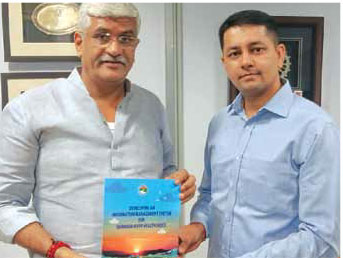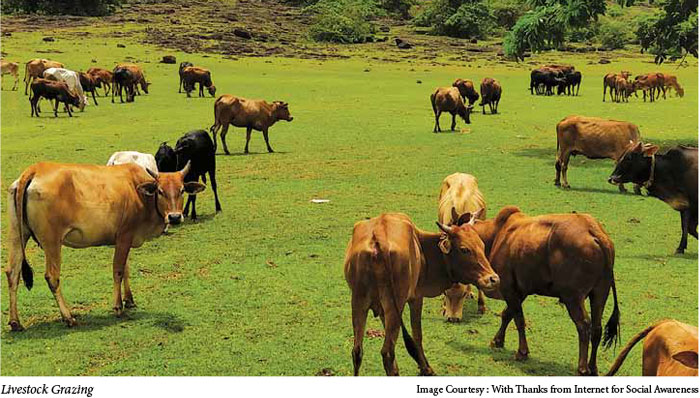
How Healthy are our Rivers?
River Narmada in its initial flow at Amarkantak
By Kartik Sapre
The Narmada River Health Index was conceptualised by Mr. Anil Madhav Dave. The late Anil Dave, who served as the Union Minister for Environment, Forest and Climate Change, renowned for his dedication and commitment to traditional values and inclination towards contemporary ideas and innovative thinking. Quite understandably, he was also an advocate of responsible living.
Anil Dave’s commitment to environment and ecology stood out most prominently in his concern for rivers, which he believed are living entities and a single, holistic segment from their origin to confluence. Hence, rivers should be viewed beyond the geographical boundaries of states. Also, their health should be checked and monitored periodically like that of humans. Dave ji constantly encouraged and designed an entire gamut of activities with maximum community involvement in them. It is with his blessings that we began working on this report, which incorporates water testing, one of Dave ji’s ideas to acquaint, educate and associate children with science and logical thinking along with traditional and cultural practices.
We feel the deteriorating health of our rivers calls for our urgent attention. The fact is only 3 percent of all water is freshwater and fit for human consumption. Of this freshwater, less than 0.3 percent is in rivers, lakes and the atmosphere. Approximately 98.9 percent lies in the form of ice, ocean and groundwater. Rivers, along with their catchment areas must be considered as a holistic living entity and their surrounding land, riverbed, aquatic life, ponds, groundwater, forest, biodiversity and human settlements are indicators of river’s health and must therefore be scientifically monitored.
Like the human immune system, rivers too have their own systems to keep themselves healthy and sustained. However, various factors like the behaviour of riparian societies, social structures, customs, local, national and internationsal policies play an important role in the health of river system. Various human activities are a cause of their ill health. If not checked or monitored for a long time, causes deterioration in the health of river, which may sometime become incurable and later can cause the extinction of the riverine system. We believe that river health should be monitored, as is required for humans. The river health index is therefore a compilation of various parameters depicting changes, issues, condition, quality and overall functioning of the system.

Handing over report to H’noble Union Minister
Mr Gajendra Singh Shekhawat
In 2011-2012, Narmada Samagra began collecting samples and relevant data from the banks through our field coordinators and with the help of volunteers; the gamut of data was named Narmada River Health Index. Further to this, we initiated a Water Testing program with the idea of community-based monitoring, which was successfully implemented from 2014 to 2017. This was achieved with the help of school children studying in villages on the banks of Narmada and our volunteers.
The water testing program was taken up in the field with our dedicated volunteers and dynamic students from both government and private schools, on the banks of River Narmada. We wish to express our heartfelt gratitude to Lok Shikshan Sanchanalaya, Department of School Education, Government of Madhya Pradesh, for supporting the project and encouraging the government schools (along the banks of Narmada) to participate in this program, which helped in spreading awareness among the school kids. This all was possible because of support from Merck India Ltd, who adopted the water testing program under their Corporate Social Responsibility (CSR) and extended their support both financially and morally. The results and related reports led us to the conclusion that continuous monitoring is required and altogether we compiled the data to form a report on “Developing an Information Management System for Developing Narmada River Health Index”. This publication received ISBN as well and the first copy was presented to Union Minister for Jal Shakti, Mr. Gajendra Singh Shekhawat in August 2019.
There are various other studies and research being conducted worldwide on the water quality and river health. Many
of these came up with different methodologies, such as based on Water Quality Index; Overall Pollution Index; Ecological Health Index; Ecological Quality Index and River Pollution Index, etc. The parameters like physical, chemical, biological, geomorphological, hydrological, aquatic, ecological, surface water quality, pollution level, bacteriological, florafauna, water streams coming to river, base-flow, soil, rocks, biodiversity, water use pattern, discharge sources in river, riparian culture, fisheries & aquaculture, etc., are being studied at different levels in different parts of the country as well as around the world.
Many such references and researches are available through which a proper River Health Indicators may be redefined, and the index may be framed, and an Information Management System can be developed. The behaviour of riparian society, extensive use of chemicals and fertilizers in agriculture, deforestation, pollution by cities/towns and industries on the banks, mining, climate change, etc. are some key issues which directly or indirectly impact the health of the river. All these have different departments/institutions/organizations working on them separately for their welfare and improving policies. However, an innovative and integrated approach is required to study and analyse the impacts of these activities on the overall health of the river. All these information/data and practices can be compiled and analysed to frame a Holistic Management System for River Health Index.
Well-coordinated intergovernmental practices will definitely help, with proper consultation from experts and locals as well. The proper utilization of socio-economic data and combination of cultural and traditional practices and indigenous knowledge will surely bring change.
It is well documented that how healthy, flowing rivers with unpolluted ample water is critical for the survival of our country. We can go ahead and say, that in the well-being of the rivers, depends our health and future. If we neglect the health of the rivers and compromise on this most vital element our sustenance, then we are putting our own existence on stake.
The author was earlier associated with Anil Madhav Dave ji for eight years as his PA/PS and later as his APS in MoEFCC. He is presently associated with Narmada Samagra Nyas based in Bhopal and working full time managing and coordinating the work and also continuing the work initiated on River Conservation on River Narmada. He’s currently pursuing his Ph.D from Centre For Rural Development and Technology, IIT Delhi.




